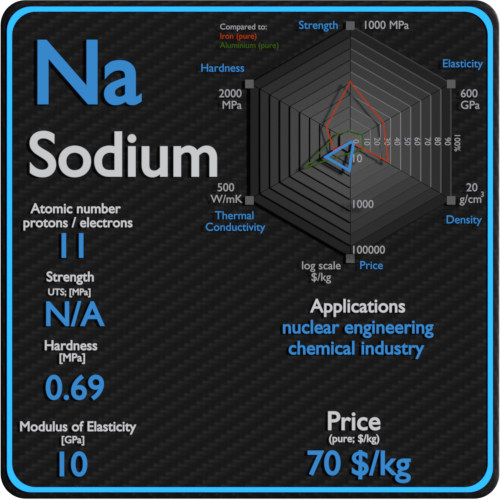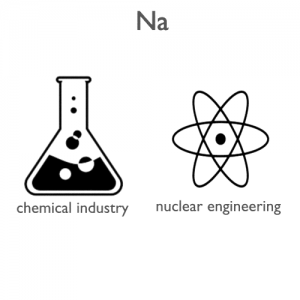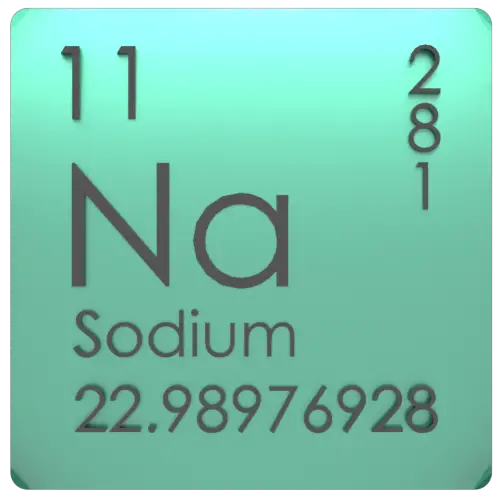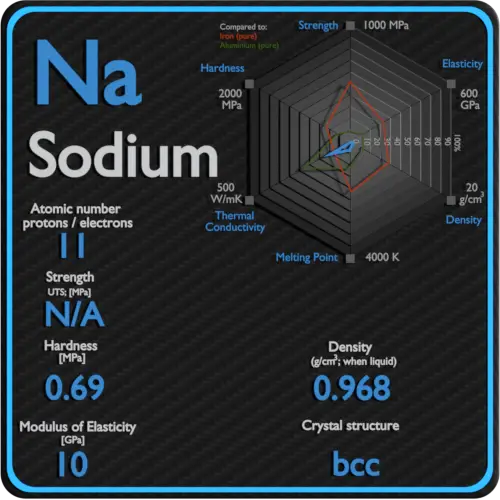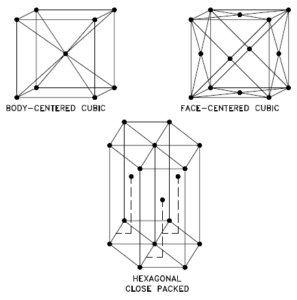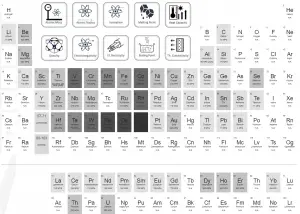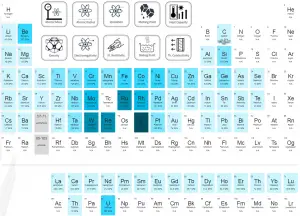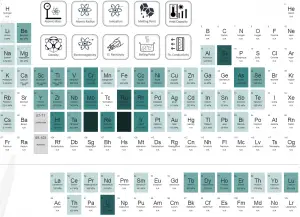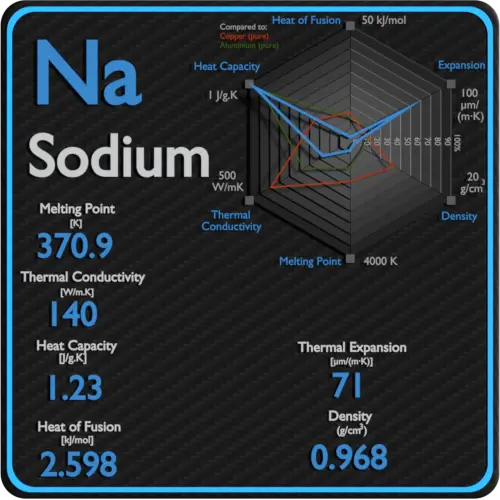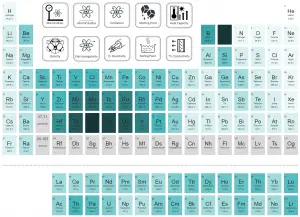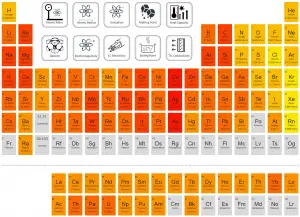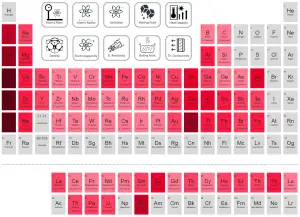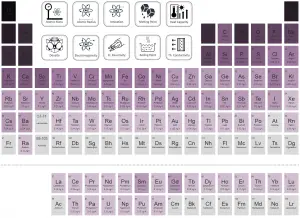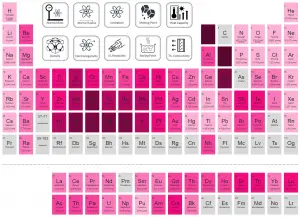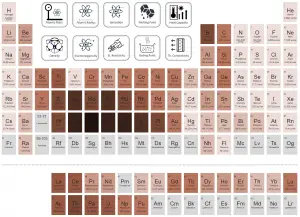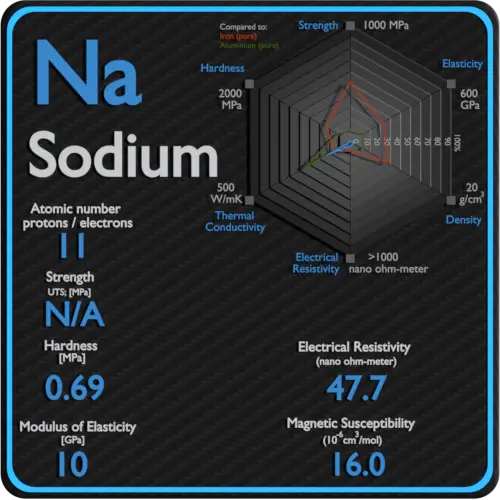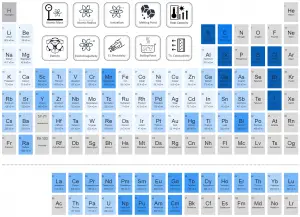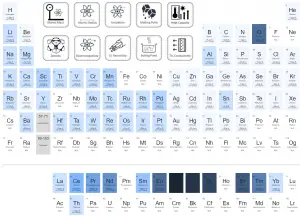About Sodium
Sodium is a soft, silvery-white, highly reactive metal. Sodium is an alkali metal, being in group 1 of the periodic table, because it has a single electron in its outer shell that it readily donates, creating a positively charged atom—the Na+ cation.
Summary
| Element | Sodium |
| Atomic number | 11 |
| Element category | Alkali Metal |
| Phase at STP | Solid |
| Density | 0.968 g/cm3 |
| Ultimate Tensile Strength | N/A |
| Yield Strength | N/A |
| Young’s Modulus of Elasticity | 10 GPa |
| Mohs Scale | 0.4 |
| Brinell Hardness | 0.69 MPa |
| Vickers Hardness | N/A |
| Melting Point | 97.8 °C |
| Boiling Point | 883 °C |
| Thermal Conductivity | 141 W/mK |
| Thermal Expansion Coefficient | 71 µm/mK |
| Specific Heat | 1.23 J/g K |
| Heat of Fusion | 2.598 kJ/mol |
| Heat of Vaporization | 96.96 kJ/mol |
| Electrical resistivity [nanoOhm meter] | 47.7 |
| Magnetic Susceptibility | +16e-6 cm^3/mol |
Applications of Sodium
Metallic sodium is used mainly for the production of sodium borohydride, sodium azide, indigo, and triphenylphosphine. A once-common use was the making of tetraethyllead and titanium metal; because of the move away from TEL and new titanium production methods. An electric current and sodium vapor combine to form a yellowish glow. This principle is used for the making of sodium vapor lamps. Sodium is occasionally used as a heat exchange medium in nuclear power plants. Liquid sodium is sealed into pipes surrounding the reactor core. Generated heat is absorbed by sodium and forced through the pipes in a heat exchanger which can be used to generate electricity.
Production and Price of Sodium
Raw materials prices change daily. They are primarily driven by supply, demand and energy prices. In 2019, prices of pure Sodium were at around 70 $/kg.
Employed only in rather specialized applications, only about 100,000 tonnes of metallic sodium are produced annually. Sodium is now produced commercially through the electrolysis of molten sodium chloride, based on a process patented in 1924. This is done in a Downs cell in which the NaCl is mixed with calcium chloride to lower the melting point below 700 °C.
Source: www.luciteria.com
Mechanical Properties of Sodium
Strength of Sodium
In mechanics of materials, the strength of a material is its ability to withstand an applied load without failure or plastic deformation. Strength of materials basically considers the relationship between the external loads applied to a material and the resulting deformation or change in material dimensions. In designing structures and machines, it is important to consider these factors, in order that the material selected will have adequate strength to resist applied loads or forces and retain its original shape. Strength of a material is its ability to withstand this applied load without failure or plastic deformation.
For tensile stress, the capacity of a material or structure to withstand loads tending to elongate is known as ultimate tensile strength (UTS). Yield strength or yield stress is the material property defined as the stress at which a material begins to deform plastically whereas yield point is the point where nonlinear (elastic + plastic) deformation begins.
See also: Strength of Materials
Ultimate Tensile Strength of Sodium
Ultimate tensile strength of Sodium is N/A.
Yield Strength of Sodium
Yield strength of Sodium is N/A.
Modulus of Elasticity of Sodium
The Young’s modulus of elasticity of Sodium is 10 GPa.
Hardness of Sodium
In materials science, hardness is the ability to withstand surface indentation (localized plastic deformation) and scratching. Brinell hardness test is one of indentation hardness tests, that has been developed for hardness testing. In Brinell tests, a hard, spherical indenter is forced under a specific load into the surface of the metal to be tested.
Brinell hardness of Sodium is approximately 0.69 MPa.
The Vickers hardness test method was developed by Robert L. Smith and George E. Sandland at Vickers Ltd as an alternative to the Brinell method to measure the hardness of materials. The Vickers hardness test method can be also used as a microhardness test method, which is mostly used for small parts, thin sections, or case depth work.
Vickers hardness of Sodium is approximately N/A.
Scratch hardness is the measure of how resistant a sample is to permanent plastic deformation due to friction from a sharp object. The most common scale for this qualitative test is Mohs scale, which is used in mineralogy. The Mohs scale of mineral hardness is based on the ability of one natural sample of mineral to scratch another mineral visibly.
Sodium is has a hardness of approximately 0.4.
See also: Hardness of Materials
Sodium – Crystal Structure
A possible crystal structure of Sodium is body-centered cubic structure.
In metals, and in many other solids, the atoms are arranged in regular arrays called crystals. A crystal lattice is a repeating pattern of mathematical points that extends throughout space. The forces of chemical bonding causes this repetition. It is this repeated pattern which control properties like strength, ductility, density, conductivity (property of conducting or transmitting heat, electricity, etc.), and shape. There are 14 general types of such patterns known as Bravais lattices.
See also: Crystal Structure of Materials
Crystal Structure of Sodium

Thermal Properties of Sodium
Sodium – Melting Point and Boiling Point
Melting point of Sodium is 97.8°C.
Boiling point of Sodium is 883°C.
Note that, these points are associated with the standard atmospheric pressure.
Sodium – Thermal Conductivity
Thermal conductivity of Sodium is 141 W/(m·K).
The heat transfer characteristics of a solid material are measured by a property called the thermal conductivity, k (or λ), measured in W/m.K. It is a measure of a substance’s ability to transfer heat through a material by conduction. Note that Fourier’s law applies for all matter, regardless of its state (solid, liquid, or gas), therefore, it is also defined for liquids and gases.
Coefficient of Thermal Expansion of Sodium
Linear thermal expansion coefficient of Sodium is 71 µm/(m·K)
Thermal expansion is generally the tendency of matter to change its dimensions in response to a change in temperature. It is usually expressed as a fractional change in length or volume per unit temperature change.
Sodium – Specific Heat, Latent Heat of Fusion, Latent Heat of Vaporization
Specific heat of Sodium is 1.23 J/g K.
Heat capacity is an extensive property of matter, meaning it is proportional to the size of the system. Heat capacity C has the unit of energy per degree or energy per kelvin. When expressing the same phenomenon as an intensive property, the heat capacity is divided by the amount of substance, mass, or volume, thus the quantity is independent of the size or extent of the sample.
Latent Heat of Fusion of Sodium is 2.598 kJ/mol.
Latent Heat of Vaporization of Sodium is 96.96 kJ/mol.
Latent heat is the amount of heat added to or removed from a substance to produce a change in phase. This energy breaks down the intermolecular attractive forces, and also must provide the energy necessary to expand the gas (the pΔV work). When latent heat is added, no temperature change occurs. The enthalpy of vaporization is a function of the pressure at which that transformation takes place.
Sodium – Electrical Resistivity – Magnetic Susceptibility
Electrical property refers to the response of a material to an applied electric field. One of the principal characteristics of materials is their ability (or lack of ability) to conduct electrical current. Indeed, materials are classified by this property, that is, they are divided into conductors, semiconductors, and nonconductors.
See also: Electrical Properties
Magnetic property refers to the response of a material to an applied magnetic field. The macroscopic magnetic properties of a material are a consequence of interactions between an external magnetic field and the magnetic dipole moments of the constituent atoms. Different materials react to the application of magnetic field differently.
See also: Magnetic Properties
Electrical Resistivity of Sodium
Electrical resistivity of Sodium is 47.7 nΩ⋅m.
Electrical conductivity and its converse, electrical resistivity, is a fundamental property of a material that quantifies how Sodium conducts the flow of electric current. Electrical conductivity or specific conductance is the reciprocal of electrical resistivity.
Magnetic Susceptibility of Sodium
Magnetic susceptibility of Sodium is +16e-6 cm^3/mol.
In electromagnetism, magnetic susceptibility is the measure of the magnetization of a substance. Magnetic susceptibility is a dimensionless proportionality factor that indicates the degree of magnetization of Sodium in response to an applied magnetic field.
